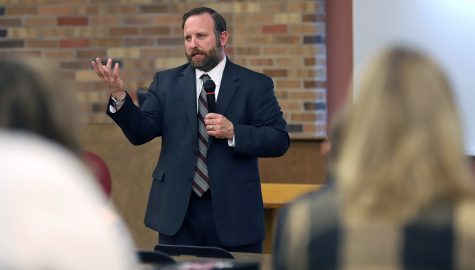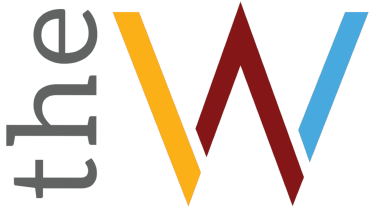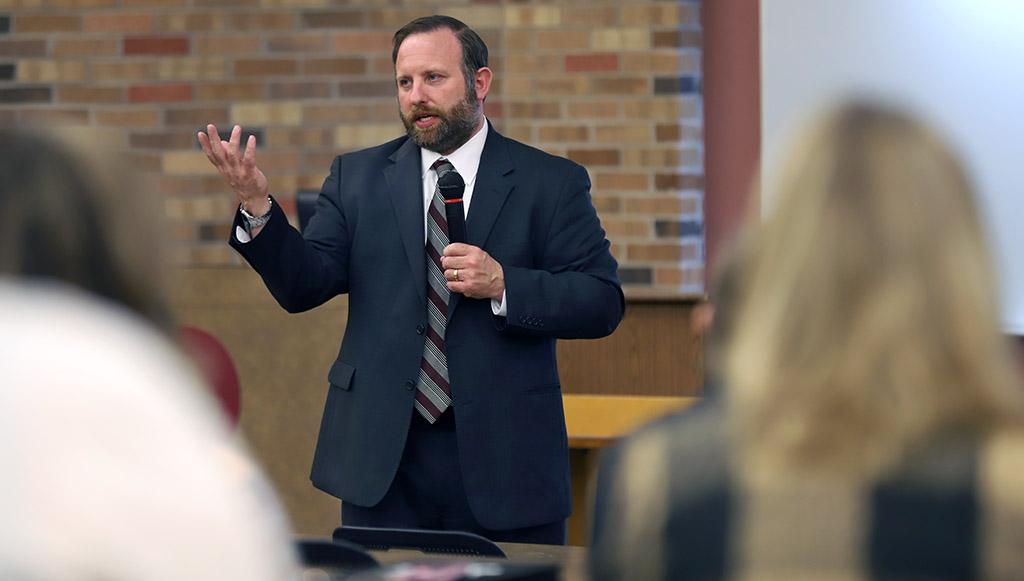Enrollment vice president candidate, Jim Anderson talks improving University brand
April 18, 2018

Jim Anderson, vice president candidate, speaks to staff members during the Vice President for Enrollment Management candidate forum at Dillard 101 on Monday, April 16, 2018. Photo by Jeromy Stacy
With 15 years of experience in higher education, background in consultancy and a psychology degree under his belt, Jim Anderson has presented himself as the best candidate to become the new Vice President of Enrollment on Campus.
“I found this position at Midwestern to be a very exciting opportunity. It’s a new position for Midwestern, but it’s more than that. It’s changing in the way that we’re going to organize ourselves and lead our institution,” said Anderson, addressing a panel discussion at Dillard 101 on April 16.
Anderson serves as vice president for enrollment services at Boise State University, Idaho and also an associate consultant in strategic enrollment planning and recruitment planning since 2011.
He said the creation of a cabinet level position to address enrollment management is a serious commitment that will help promote the MSU brand.
“Midwestern is a university that has a great mission, serves a great population and I think you all deserve a round of applause for that. The mission of the university is one that is founded in a liberal arts mission and has expanded beyond that but seeks to grow [and] also maintain its institutional identity while it does so and that is of utmost importance,” Anderson said.
In November 2017, the Board of Regents approved, in concept, creating a new position for the vice president — one solely to oversee enrollment so Keith Lamb, now vice president of enrollment management and student affairs, would be able to devote his attention to student affairs.
Faculty and staff have highlighted enrollment as a problem largely because the university budget depends heavily on enrollment each semester.
At the presentation on Monday, about 40 attendees received the opportunity to question the candidate on his vision for the department.
Anderson said, one of the greatest areas of opportunity is improving the Campus website to show a more personal side to the MSU experience.
“You got it shining outside so it’s looking very good. Clicking a little at one or two pages is where the heavy lifting needs to be done. Some of the academic program pages are catalog driven and not promotion driven. Understanding where we are and the needs of the department are not necessarily advertising the catalog as much as is advertising the program and great faculty,” Anderson said.
He said the aim is to attract students by reaching them at their level.
“Does the catalog need to be the first thing on the website that a student sees when they want to identify with a program? No. They want to see what recent graduates are doing, they want to see what jobs they can get with that, what research or scholarship opportunities are available and is this the right program for me? That’s what they want,” Anderson said.
Melissa Poling, freshman admissions evaluator, raised concerns about morale in the workplace. She said it is important for the admissions and financial aid departments to do their job.
“We need to be able to understand our leadership is taking us in the right direction and they are listening to where we find improvements, working with us on those [and] taking our concerns to the higher level. It’s also important for us to have good morale as a team because teamwork always accomplishes more,” Poling said.
Anderson said it is all about having a, “wear out your shoe approach.”
“That means that they are moving around. They are approachable. They are in front of their staff. It’s an opportunity to get people together that may not run into each other on a daily basis,” Anderson said.
He said it is important for staff to talk about where they see themselves in their work and their contribution to the success of the University.
“I like to make the numbers seem real and we present a lot of numbers in enrolment and management, we sit behind them but we also have to have staff see themselves in those numbers because that’s the result. The university is the people. It’s not the excel chart that’s on the screen, ”Anderson Said.
The candidate seemed to hit a warm spot with the room of employees who could not stop laughing at his humor or paying attention when he spoke.
Poling said given his experience in the field, he would be a good fit if selected for the position.
“That is probably where that comes from that wisdom that relationship with your working team. It promotes communication and trust and in turn, promotes a lot of productivity that will allow everyone to do their job better. I think he did a fantastic job presenting his experience. He was very well spoken,” Poling said.
Anderson also addressed the issue of performance metrics or the measures of an organization’s behavior, activities, and performance in increasing retention on campus.
He said it is important to have realistic goals. Create a model then give yourself time to do it.
“One of the mistakes is setting goals from metrics that are not necessarily data-informed or just goals that you back into saying, “’our budget has to look like that. So we need to produce wise students,’” Anderson said.
Anderson said it is necessary to study the market and set student goals based on what is possible.
“What is possible is always equal to what we need to do as a university. How can we make that target a reality? So we took care of the new student side of things we also then need to take care of the current student side of things when working on retention,” Anderson said.
Kathy Browning, director of financial aid, said, financial aid leveraging or the strategic investment of financial aid funds to help campuses enroll the students they desire, is also important.
“[It is] extremely important to a student so that we can ensure that their total need is being met not just through scholarships but financial aid. We would want to make sure that the money could be spread out over a larger number of students and we could try to help as many students as we possibly could,” Browning said.
Anderson said, “It falls under boosting the brand. We’re trying to overcome a deficiency. It’s a way to influence enrollment. So if we build our brand strong, the less that we have to dip into the well to offer an incentive for students to enroll the more value they see.”
He said it is necessary to satisfy unmet needs and how affordable the university is as some students gravitate towards scholarships while others look at the overall package.
Browning said, “Any kind of leveraging we can do would be a bonus for our students and this candidate had a vision of how we could leverage a student’s financial aid and get more bang for the buck so we could cover students with the limited resources that we have and this also touches on middle-income students.”
Anderson said his large university experience and consultancy, having worked with 12 different institutions, will be a plus to enrollment on campus.
“My Boise State experience has helped me with that. In that, we’re not a resource-rich institution. All the strategies I have implemented at Boise State have come from existing resources without a dollar more of outside money. In fact, in two years we saw appropriate budget cuts in most positions. I wouldn’t be doing what I’m doing if I didn’t win more than I lost,” Anderson said.
He said if selected, his initial days in office would focus on establishing relationships and putting structures in place and begin that work right away.
“We don’t have time to wait so some of the early conversations are going to be setting up meetings and relationships with deans, department heads, students and focus groups. I hope to start the groundwork by being able to listen, learn and then take the appropriate actions for us to go recruit and start that this fall [September].”
Other Candidates

